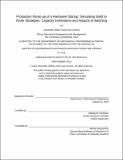| dc.contributor.advisor | Stanley B. Gershwin. | en_US |
| dc.contributor.author | Van Grootel, Alexander Willem Anton | en_US |
| dc.contributor.other | Massachusetts Institute of Technology. Department of Mechanical Engineering. | en_US |
| dc.date.accessioned | 2017-02-22T15:59:26Z | |
| dc.date.available | 2017-02-22T15:59:26Z | |
| dc.date.copyright | 2016 | en_US |
| dc.date.issued | 2016 | en_US |
| dc.identifier.uri | http://hdl.handle.net/1721.1/107023 | |
| dc.description | Thesis: M. Eng. in Advanced Manufacturing and Design, Massachusetts Institute of Technology, Department of Mechanical Engineering, 2016. | en_US |
| dc.description | This electronic version was submitted by the student author. The certified thesis is available in the Institute Archives and Special Collections. | en_US |
| dc.description | Cataloged from student-submitted PDF version of thesis. | en_US |
| dc.description | Includes bibliographical references (pages 96-98). | en_US |
| dc.description.abstract | When a startup scales up its enterprise the manufacturing system used to govern the production process should be robust enough to scale up with it. NVBOTS is in a position where it plans to scale up production by an order of magnitude within a few months. NVBOTS's manufacturing systems should therefore be reevaluated to ensure its design will meet requirements. In order to model the production process at NVBOTS a discrete event manufacturing simulation is developed. Both a Push system and a Build to Order (BtO) system are initially considered. The trade-offs that exist in these policies are identified and analyzed. A recommendation is made to adopt a BtO policy and to build in a batch size of one. Based on the feedback from NVBOTS an advanced model is then developed, which incorporates some benefit of batching. The effects of batch size on lead time, inventory level and capacity are investigated. Even when assuming a 30% setup time for assembly steps, the optimal batch size with regards to lead time or inventory levels remains at one. However, it is found that batching has a significant impact on the capacity of the system. The advanced model also introduces a new policy named Sell x Build y (SxBy, e.g. S1B6), which allows NVBOTS to operate in larger batches by minimizing the effect on lead time while keeping inventory roughly constant. With the current labor levels, and using a S1B6 policy, the model estimates a maximum capacity of around 23 printers per month. The expected 99 percentile lead time of this policy is roughly 11 work days. The work described in this thesis covers roughly half of the project on manufacturing systems at NVBOTS. The other half is covered in Yugal Raj Jain's thesis [1]. Jain's thesis focuses on multiple product lines and late-stage differentiation, and analyses CONWIP and CONWIP-BtO policies. In contrast, this thesis focuses on the capacity at the current facility and the policies which NVBOTS should look to adopt in the short term. The policies that this thesis considers includes Push, BtO and SxBy policies. | en_US |
| dc.description.statementofresponsibility | by Alexander Willem Anton van Grootel. | en_US |
| dc.format.extent | 119 pages | en_US |
| dc.language.iso | eng | en_US |
| dc.publisher | Massachusetts Institute of Technology | en_US |
| dc.rights | MIT theses are protected by copyright. They may be viewed, downloaded, or printed from this source but further reproduction or distribution in any format is prohibited without written permission. | en_US |
| dc.rights.uri | http://dspace.mit.edu/handle/1721.1/7582 | en_US |
| dc.subject | Mechanical Engineering. | en_US |
| dc.title | Production ramp-up of a hardware startup : simulating build to order strategies, capacity estimations and impacts of batching | en_US |
| dc.title.alternative | Simulating build to order strategies, capacity estimations and impacts of batching | en_US |
| dc.type | Thesis | en_US |
| dc.description.degree | M. Eng. in Advanced Manufacturing and Design | en_US |
| dc.contributor.department | Massachusetts Institute of Technology. Department of Mechanical Engineering | |
| dc.identifier.oclc | 971136327 | en_US |
